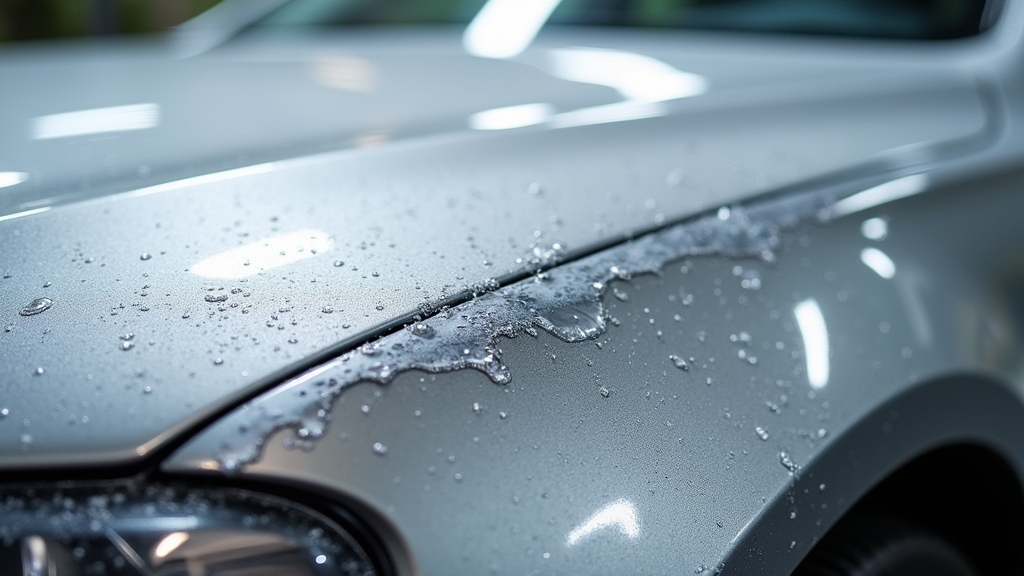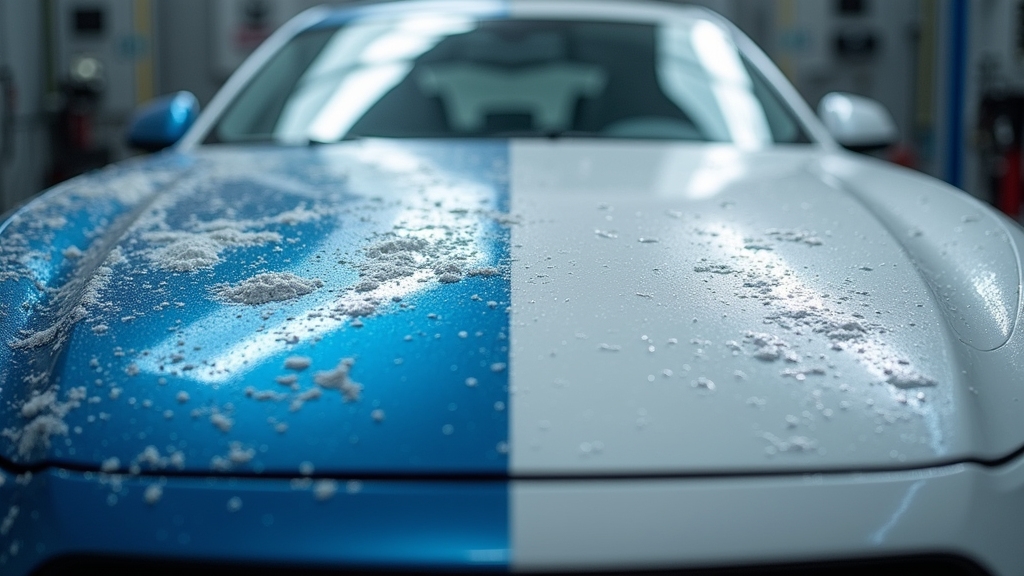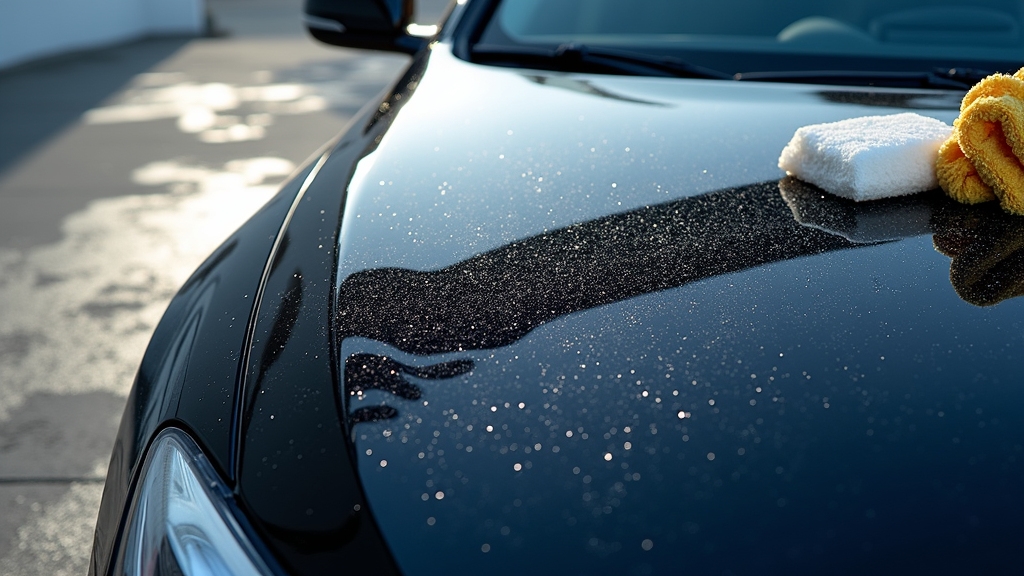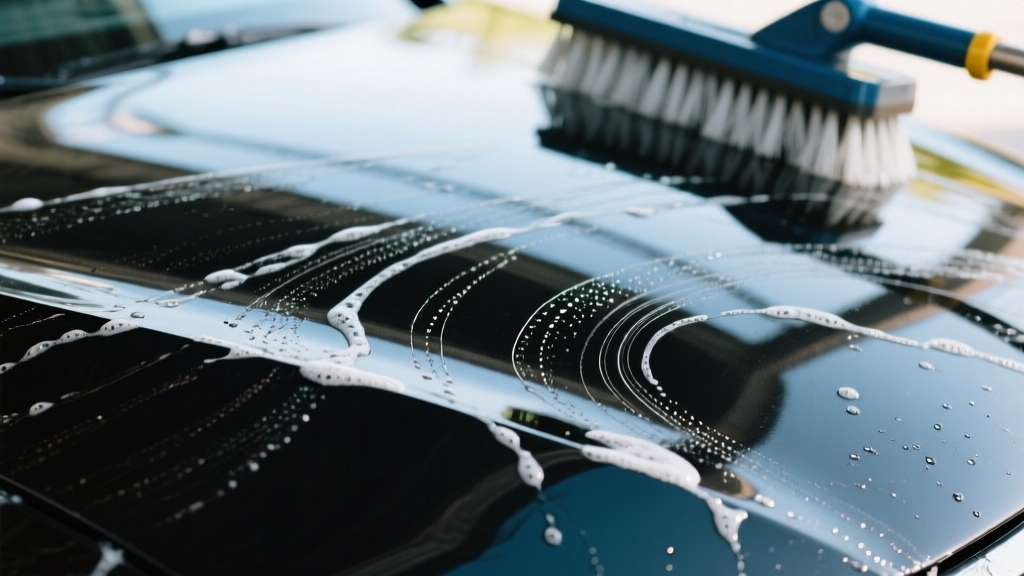Yes, a car wash can scratch your car, especially if it uses abrasive brushes or if debris is trapped in the cleaning equipment. Mechanical action from stiff fibers and conveyor rollers can cause micro-scratches that dull the clear coat.
Harsh chemicals may strip protective wax, making paint more vulnerable. Touchless washes reduce contact damage but can still affect coatings chemically. Understanding these factors helps you protect your vehicle’s finish more effectively.
Key Takeaways
- Automatic car washes with abrasive brushes or contaminated cloth strips can cause micro-scratches, swirl marks, and dull the clear coat over time.
- Harsh chemicals and high-pH soaps in car washes can strip wax layers, increasing paint vulnerability to scratches and fading.
- Mechanical impacts from worn brushes, spinning components, or trapped debris often cause visible scratches, dents, or chips on vehicle surfaces.
- Touchless car washes minimize contact and reduce scratch risk but may still cause damage through high-pressure water jets or harsh chemicals.
- Regular vehicle inspection, waxing, and choosing reputable, well-maintained car washes help prevent surface damage and maintain paint protection.
How Automatic Car Washes Cause Paint Scratches?

Although automatic car washes offer convenience, they often cause paint scratches through a combination of chemical, mechanical, and water-related factors.
Industrial-strength alkaline detergents can degrade your vehicle’s clear coat, especially on dark finishes, accelerating fading and oxidation. These harsh chemicals may also etch window trims and plastic moldings. Additionally, improper maintenance of the wash equipment can increase the risk of abrasive contamination being transferred to your paint.
Water quality matters too. Recycled water often contains fine abrasive particles that create micro-scratches, while high-pressure nozzles can force grit against your paint with damaging force. Improper drying leaves water spots and mineral etching, and excessive water pressure stresses paint edges. Hard water contains calcium and magnesium carbonates, which contribute to permanent paint damage if not properly rinsed and dried.
Mechanically, spinning components and conveyor rollers can unevenly press and drag contaminants, causing gouges and swirl marks. Even touchless systems’ worn cloth strips subtly abrade your paint. This cumulative micro-damage dulls gloss and compromises clear coat protection over time.
The Role of Brushes and Debris in Surface Damage
When brushes make contact with your vehicle, they can grind embedded debris into the clearcoat, causing micro-scratches and swirl marks.
The abrasive particles trapped within brush fibers act like sandpaper, intensifying surface abrasion during each wash cycle. It is important to understand how filtration efficiency in cleaning systems can reduce the amount of abrasive debris exposure.
Understanding these mechanical interactions is key to minimizing paint damage from brush-based car washes.
Reports indicate that debris and dirt on brushes are a common cause of such surface damage.
Brush Contact Effects
Since brushes play a central role in automated car washes, understanding how their materials and movement affect your vehicle’s paint is essential. Brushes made from synthetic or natural fibers vary in stiffness, directly impacting the contact pressure on your paint surface.
Softer brushes minimize abrasion but can still create swirl marks with repeated exposure. Stiffer bristles increase the risk of mechanical abrasion, potentially damaging the clear coat, especially on older finishes. Rotating brushes apply continuous force, intensifying micro-scratches and swirl patterns. Rotating brushes collect grit from previous cars, dragging particles across paint like sandpaper.
The dynamic movement scrubs the paint surface horizontally, similar to sandpaper action, accelerating clear coat wear. Improper maintenance leads to uneven brush wear and inconsistent pressure, worsening damage. Regular inspection and cleaning of brushes can reduce the accumulation of contaminants that exacerbate surface abrasion, similar to recommended HVAC maintenance practices in vehicles.
Embedded Debris Risks
How does debris embedded in car wash brushes affect your vehicle’s paint? When brushes accumulate dirt, grit, and tiny stones from previous washes, these particles embed into their surfaces.
As the brushes move over your paint, embedded debris acts like abrasives, dragging contaminants and causing micro-scratches or swirl marks that gradually dull your finish. Even small amounts of debris accelerate surface damage through repeated grinding. This abrasive action is similar to the crystallized DEF particles that cause damage in fuel systems by clogging and wearing down components.
Additionally, larger particles trapped in brushes can strike your car’s body with force, leading to dents or dings, especially on vulnerable parts like spoilers. Many automatic car washes don’t adequately clean brushes, increasing contamination risks. Over time, this repeated contact causes micro-abrasions, leading to visible swirl marks.
To protect your vehicle’s paint, be aware that brush maintenance and the presence of embedded debris critically influence the extent of surface damage during washes.
Surface Abrasion Mechanisms
Beyond the risks posed by embedded debris, the mechanical action of brushes plays a significant role in surface abrasion during car washes. Brushes apply friction to remove dirt, but if their bristles are abrasive or contaminated, they can cause microscopic scratches on your car’s clearcoat.
Modern soft-touch brushes use gentler materials, yet improper maintenance or embedded hard particles can increase abrasion risks. Factors like brush rotation speed, pressure, and duration of contact directly influence scratch formation and swirl marks over time. Abrasion resistance is a key performance parameter for coating selection that helps protect against years of wear, shine, and water beading claims.
Additionally, worn or stiff brushes elevate damage potential by creating harder contact points. To minimize abrasion, car washes optimize water flow and detergents to lubricate surfaces, balancing cleaning efficiency with protection.
Understanding these mechanisms helps you appreciate how brushes and debris contribute to cumulative surface wear.
Chemical Effects on Clear Coat and Paint Longevity
When you use harsh chemicals in car wash soaps, they can strip away the protective wax layer on your vehicle, exposing the clear coat to environmental damage. High-pH soaps soften the clear coat, increasing susceptibility to scratches and swirl marks. Brushes and cleaning tools may also cause scratches and swirl marks on paint, further compromising its surface. Choosing cleaning products with balanced pH helps maintain the protective layers and reduce vulnerability to damage.
Acidic rinse agents, if not fully rinsed, may etch or dull the clear coat surface. Frequent exposure to strong surfactants removes natural oils, accelerating paint aging and fading. Similar to how oil filters must balance efficiency and flow to protect engines, car wash chemicals must be carefully formulated to avoid harming the clear coat.
Since clear coats are polyurethane or acrylic urethane-based plastics, they degrade chemically under repeated harsh chemical contact. Using detergents designed for automotive paint with balanced pH minimizes micro-etching and surface roughness.
Maintaining the wax or sealant layer slows chemical penetration, preserving clear coat integrity and prolonging paint longevity by reducing vulnerability to UV, oxidation, and environmental pollutants. Additionally, avoiding mechanical cleaning methods that use brushes or harsh tools helps prevent scratches and swirl marks that can dull and wear down the vehicle’s exterior finish.
Comparing Automatic and Touchless Car Wash Systems

When you choose between automatic and touchless car washes, understanding their mechanical versus chemical cleaning impacts is essential. Automatic systems rely on physical brushes that scrub but risk surface abrasion. However, the effectiveness often depends on the quality of maintenance of these brushes and equipment.
Touchless systems use high-pressure jets and chemicals to minimize paint contact. You’ll want to balance effective grime removal with paint protection strategies tailored to your vehicle’s finish and sensitivity. Touchless car washes are generally gentler on paint, reducing the risk of scratches or swirl marks.
Mechanical Vs Chemical Impact
Although both automatic and touchless car wash systems aim to clean your vehicle efficiently, they differ considerably in how they impact your car’s surface. Automatic washes use rotating brushes that can trap dirt, causing micro scratches and swirl marks, while touchless systems rely heavily on strong chemicals that risk dulling or etching the clearcoat.
| Impact Type | Automatic Wash (Brush) | Touchless Wash (Chemical) |
|---|---|---|
| Physical Damage | Swirl marks, scratches, fixture harm | Minimal physical abrasion |
| Chemical Damage | Moderate chemical exposure | Stronger, potentially corrosive chemicals |
| Long-Term Effect | Accumulated mechanical wear | Clearcoat dulling, accelerated oxidation |
Balancing these effects is crucial, much like choosing between mechanical and chemical impacts when selecting suspension components for your vehicle.
Paint Protection Strategies
Understanding the distinct impacts of automatic and touchless car wash systems sets the stage for effective paint protection strategies.
Automatic washes use rotating brushes or cloths that can harbor dirt and cause scratches if not properly maintained. You should verify these brushes are regularly inspected and replaced to minimize paint damage risk. Additionally, regular maintenance and cleaning of the brushes help prevent surface abrasion during the wash cycle.
Touchless systems eliminate physical contact, reducing mechanical scratches, but may struggle with heavy grime, necessitating occasional hand detailing afterward. It is also important to use gentle car wash soap designed for vehicle surfaces to avoid damaging the paint.
To optimize paint protection, alternate between touchless and soft-cloth or hand washes, balancing thorough cleaning and minimizing abrasion.
Additionally, use pH-balanced soaps and avoid excessive water pressure to preserve wax layers.
Selecting reputable facilities with modern equipment further reduces damage risks, helping you maintain your vehicle’s finish effectively.
Vulnerable Vehicle Parts During Car Washes
Since car washes subject your vehicle to various mechanical and chemical processes, several exterior parts become particularly vulnerable to damage. The rotating brushes and cloth strips often trap debris, causing scratches and swirl marks on paint and clearcoat. Debris in water may act as abrasives, leading to fine scratches or swirl marks on paint surfaces.
Delicate components like windshield wipers and mirrors risk bending or breaking. Wheels and rims can suffer from metal-on-metal contact, while sensors and antennas may misalign or malfunction due to excessive water pressure or mechanical impact. It is important to note that high-pressure water can cause edges to peel or bubble on wrapped or delicate surfaces.
Additionally, harsh detergents and mineral deposits weaken protective layers, increasing susceptibility to etching and corrosion.
- Paint and clearcoat scratched by brushes and debris
- Windshield wipers bent or broken by automatic machinery
- Rim damage from tire-grabbing systems and brake dust corrosion
- Antennas and sensors misaligned or impaired by water pressure
- Rubber seals degraded by chemical exposure leading to leaks
Frequency and Common Causes of Car Wash Damage Claims

When you consider the vast number of vehicles passing through car washes daily, damage claims remain surprisingly infrequent, with less than 9% of car owners reporting issues. Typically, individual car wash locations see about one damage claim every few months, underscoring the rarity of such events. Car washes that use advanced equipment tend to reduce the risk of abrasion and scratches.
Most reported damages, about 62%, include scratches, chips, dents, or dings.
Common causes often stem from driver errors, such as failing to shift to neutral or improper track positioning, rather than equipment malfunctions.
Abrations frequently result when dirt, salt, or debris are present before washing, especially post-winter in snowy regions.
Insufficient vehicle inspection prior to washing also contributes to misattributed damage claims.
Recognizing customer car ownership as their most valuable possession aids in empathetic communication, which can improve handling of damage concerns.
Understanding these factors helps clarify the low but persistent occurrence of car wash-related damage claims.
Best Practices to Protect Your Car’s Finish During Washing
Despite the relatively low frequency of car wash damage claims, protecting your vehicle’s finish during washing requires deliberate care and informed choices. You should prioritize touchless or low-friction methods to reduce mechanical abrasion.
Proper maintenance and inspection of washing equipment are essential to prevent physical damage. Regular cleaning and servicing help avoid equipment malfunctions that could scratch or dent your car. Adopting careful washing techniques minimizes micro-scratches and swirl marks.
Finally, applying protective coatings enhances resistance to washing-related wear.
Use touchless car washes or microfiber tools to reduce friction.
Inspect and maintain brushes and conveyors regularly.
Employ the two-bucket wash method with grit guards.
Dry with microfiber towels to prevent swirl marks.
Apply and regularly renew ceramic coatings or wax for paint protection.
These practices collectively maintain your car’s finish integrity during routine washes.
Frequently Asked Questions
How Can I Tell if My Car’s Clear Coat Is Damaged?
You can tell your car’s clear coat is damaged if you notice dull, cloudy patches or peeling and flaking areas. Run your fingernail gently over the surface. If it catches on cracks or rough edges, that’s a sign.
Also, check if water beads poorly or if polishing leaves a white, chalky residue.
Inspect under bright light for hazy zones or discoloration, especially near edges and roof sections.
Are There Specific Car Wash Brands Known for Causing Less Damage?
Wondering if certain car wash brands are gentler on your paint? Yes, brands using touchless or soft-cloth technology tend to cause less damage. They avoid rotating brushes, reducing micro-scratches and swirl marks.
Brands offering pH-neutral chemicals and protective wax or ceramic coatings help preserve your clear coat. Choosing reputable operators who maintain their equipment regularly further minimizes risks, ensuring your car’s finish stays in top condition.
Can Regular Waxing Completely Prevent Car Wash Scratches?
No, regular waxing can’t completely prevent car wash scratches.
While waxing adds a protective layer that reduces friction and minor abrasions, it doesn’t provide full defense against physical contact or abrasive particles during washing.
Wax’s protective film wears off over time and needs reapplication.
For exhaustive scratch prevention, you’ll want to combine waxing with careful washing techniques, high-quality microfiber cloths, and consider advanced options like paint protection film on vulnerable areas.
How Do Seasonal Weather Changes Affect Car Wash Damage Risk?
Seasonal weather changes markedly impact car wash damage risk. In spring and autumn, pollen, sap, and organic debris increase abrasive residues, raising scratch risks during washing.
Summer heat thins your car’s clear coat, making it more prone to micro-scratches from dust and quick-drying soaps.
Winter salt and grime accelerate corrosion, and freezing temperatures can cause physical damage if water freezes on surfaces.
Adjust your washing technique and frequency accordingly to protect your paint.
Is It Safe to Use Car Washes on Older or Classic Cars?
Of course, you could trust a car wash to treat your classic like a newborn—if you enjoy surprises like scratches or stripped wax.
But seriously, you can safely use modern, touchless washes with gentle soaps and regulated pressure on older cars. Avoid stiff brushes and unmonitored equipment, though.
Hand washing and applying protective coatings before washes remain your best bets for preserving delicate vintage finishes while keeping grime and corrosion at bay.
Protect Your Shine Before the Next Wash
Sure, if you enjoy the thrill of microscopic scratches decorating your car like a modern art piece, automatic washes are your best bet. Brushes and debris love to tango with your paint, while harsh chemicals sneakily erode your clear coat.
Touchless systems reduce this dance but aren’t flawless. To keep your car’s finish flawless, choose your wash wisely, avoid frequent abrasive cleaning, and remember: your car’s paint isn’t invincible—treat it like fine technology, not a mud toy.




